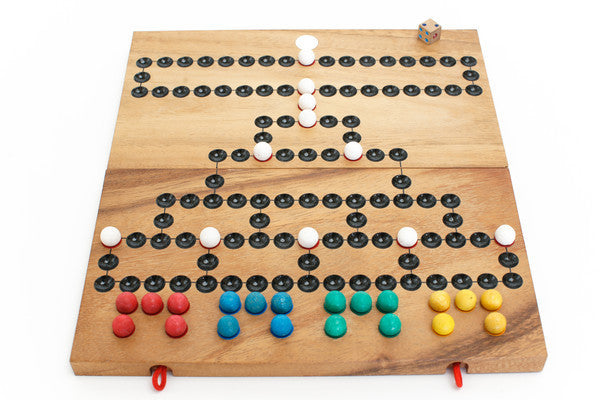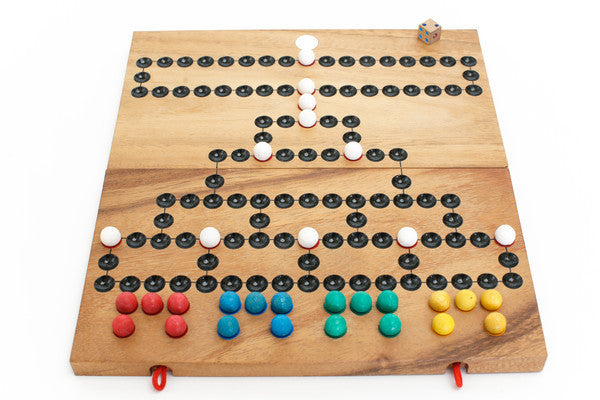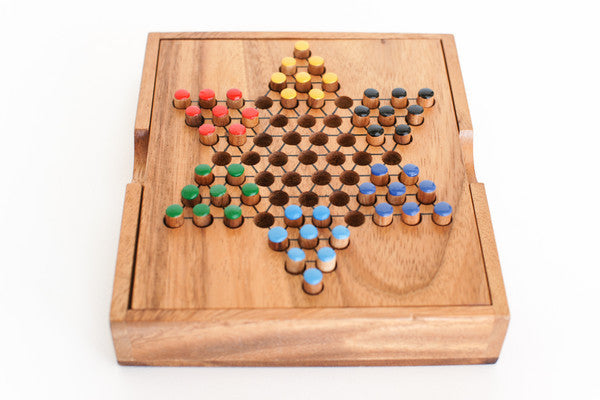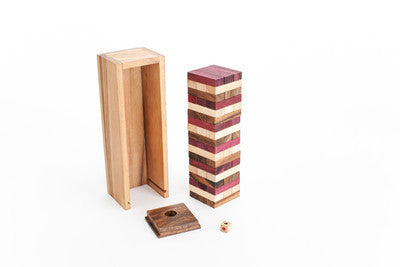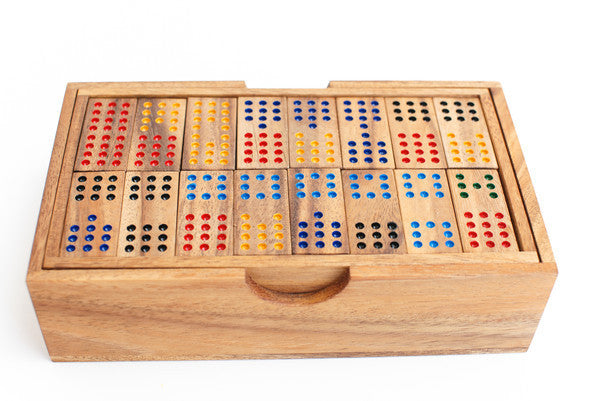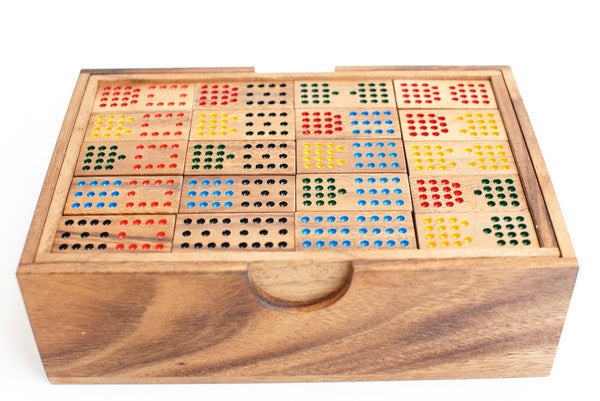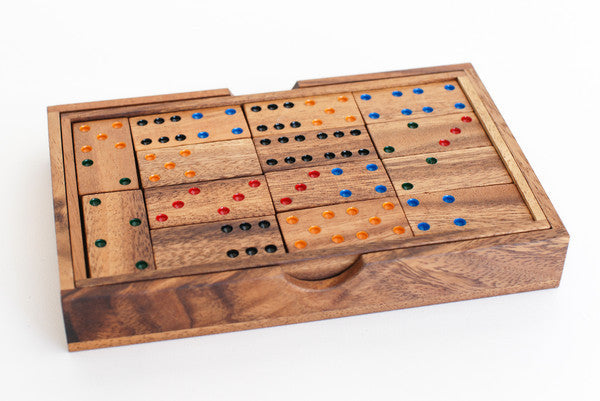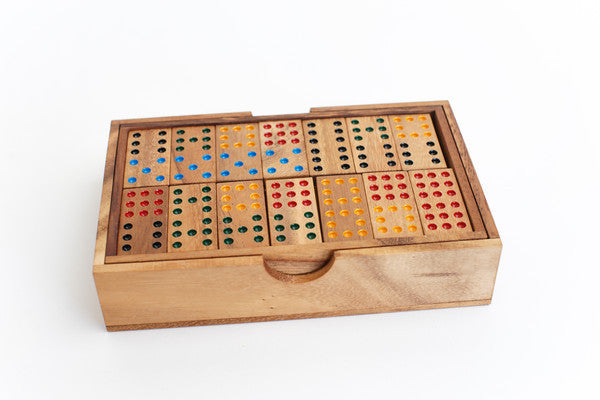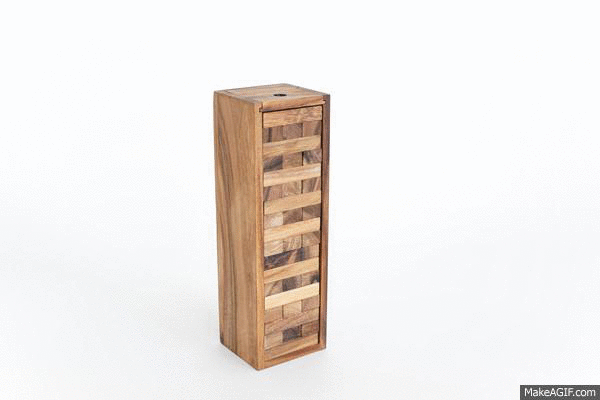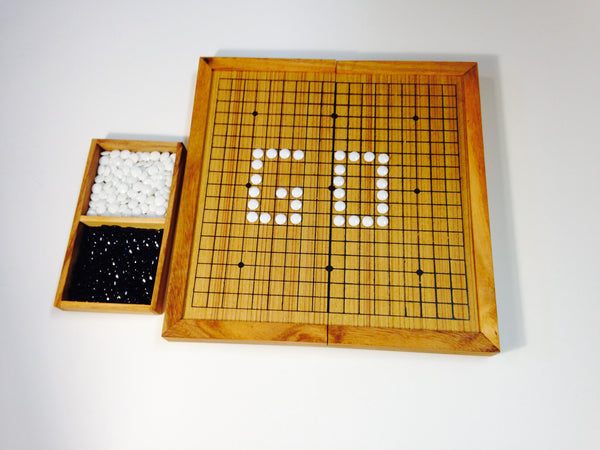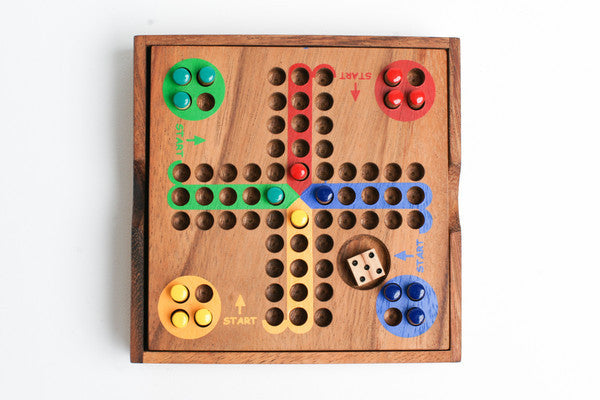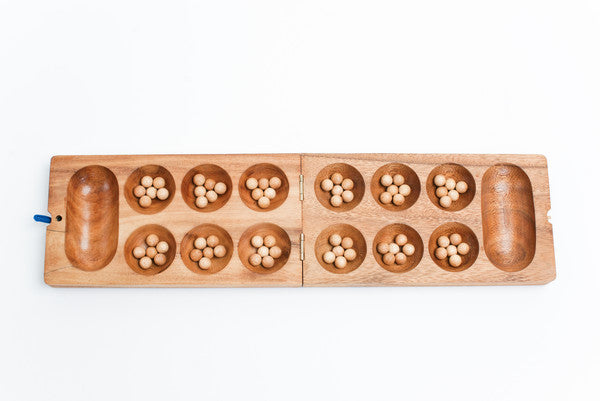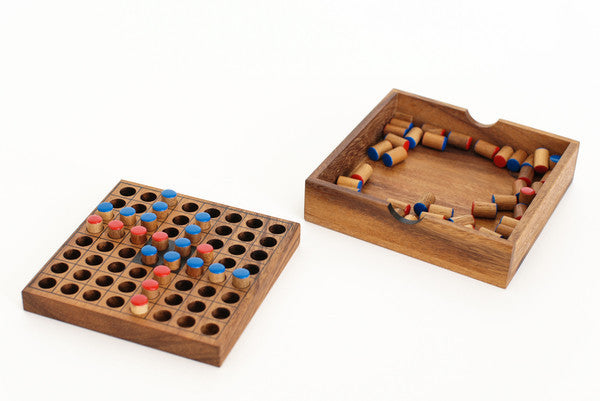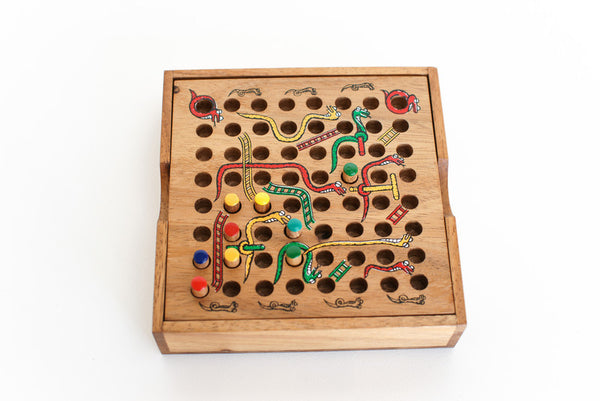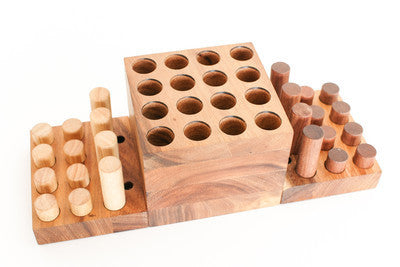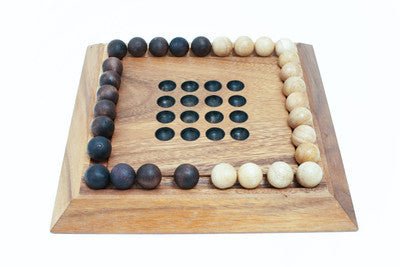Barricade Wooden Game
$40.00
A variant of Ludo or Sorry popularized in Germanic countries during the last century, barricade combines the cutthroat nature of Sorry with a linear game board.
The object of the game is to be the first player to land a ball of their color in the white goal. Each Player chooses a set of 5 pegs placing them on the matching starting positions. The white barricades are placed on the red spaces on the board. Each player rolls the die in turn, highest roll plays first. All pegs may move forward, backwards and sideways. However they have to keep the same direction during one move. The pegs must be moved by the exact number thrown. One can pass non-white pegs of the same color or a different color. You may enter as many pegs as you want to the board during the game. All pegs start from the first black dot. If a your peg lands on a space occupied by your opponents peg, your opponents peg returns to its starting position.
Barricades are obstacles that may not be passed. Only when a peg lands on a barricade exactly the player whose peg landed on a barricade may place the barricade anywhere except the first row. Used cleverly, barricades block other player's pegs and protect your own. The game ends when one player land exactly in the white goal.
Chinese Checkers - Wooden Game
Sold Out
A strategy board game which can be played by two, three, four, or six people, playing individually or with partners. The game is a modern and simplified variation of the game Halma.( invented in Germany in 1892) The rules are simple, so even young children can play
Moves can be made in any direction either moving one space into an empty slot or jumping over a peg into an empty space.
You can do several jumps (over one peg at a time) in one move. You may jump over your own or your opponents counter.
Colored Gentle Tower - Wooden Stacking Game
Sold Out
The classic stacking game can be played in 2 variations:
1. Classic- without taking in consideration the colored pieces.
2. When a color direct your move.
Each turn a player rolls the colored die and then must remove a piece of the color shown.
This game uses standard Jenga rules. Once a piece is removed it is placed on top of the stack. Pieces may only be removed from the top of the stack once there are at least 3 full rows completed over them. The game is over when the tower falls.
Domino 12 - Wooden Game
$38.99
There are countless different domino games and within each game, there are many variations of play available. The purpose of this set of rules is to get you started with a few simple and popular games.
One of the wonderful things about dominoes is that anyone can learn the basics very quickly, but as you play and progress, you will find many additional levels of the game and as your experience and skills develop, you will become a more and more formidable player. Get started with these simple games and you will find yourself getting smarter every time you play. Dominoes is a good game for your brain.
Domino 15 - Wooden Game
Sold Out
There are countless different domino games and within each game, there are many variations of play available. The purpose of this set of rules is to get you started with a few simple and popular games.
One of the wonderful things about dominoes is that anyone can learn the basics very quickly, but as you play and progress, you will find many additional levels of the game and as your experience and skills develop, you will become a more and more formidable player. Get started with these simple games and you will find yourself getting smarter every time you play. Dominoes is a good game for your brain.
Domino 6 Classic - Wooden Game
$27.50
The set consists of 28 dominoes. There are 7 doubles (same number on both ends from double blank to double six) and 21 singles (different numbers on both ends or a number and a blank).
There are countless different domino games and within each game, there are many variations of play available. The purpose of this set of rules is to get you started with a few simple and popular games. Later, we'll give you reference information for finding many other games you would enjoy.
One of the wonderful things about dominoes is that anyone can learn the basics very quickly, but as you play and progress, you will find many additional levels of the game and as your experience and skills develop, you will become a more and more formidable player. Get started with these simple games and you will find yourself getting smarter every time you play. Dominoes is a good game for your brain.
Domino 9 - Wooden Game
$35.99
There are countless different domino games and within each game, there are many variations of play available. The purpose of this set of rules is to get you started with a few simple and popular games.
One of the wonderful things about dominoes is that anyone can learn the basics very quickly, but as you play and progress, you will find many additional levels of the game and as your experience and skills develop, you will become a more and more formidable player. Get started with these simple games and you will find yourself getting smarter every time you play. Dominoes is a good game for your brain.
Gentle Tower
$34.99
The Gentle Tower game made from our beautiful Monkey Pod wood from Thailand.
Players take turns removing one block at a time from a tower constructed of 54 blocks. Each block removed is then placed on top of the tower, creating a progressively taller and more unstable structure. The player before the person who knocks over the tower wins. Same rules as the classic Jenga.
GO - Wooden Strategic Game
$46.99
GO a strategic wooden game for 2 players.
The game includes a board and two bowls of chess (black and white).
Preparation:
The board cleared; each player chooses his color of chess.
The Game:
The two players take turns to place his/her chess on board. The player with black chess starts first.
A dragon is a line of chess with the same color. When a dragon is strangled, (a line of chess isolated from chess of same color), the dragon (line of chess) is captured by the opponent.
The rules:
The player can choose to give up placing chess on his turn.
If both players decide to give up placing new chess on board on their turns, the game is over
The Winner:
The player with more chess on board wins.
Ludo - Wooden Game
Sold Out
A classic game played in many cultures with slight variation. First found in India during the 6th century in America it is known as Sorry and still played almost identically to its original design.
Players in turns, race each other around the circuit to be the first to get all of their colored pegs to the HOME-Base.
Each player picks a set of colored pegs and places them in the starting Squares of the same color.
Take turns rolling the dice, each player must roll a six before moving a piece onto the track from the starting position. During the game when a player rolls a six they get another throw.
The pegs move as to the number shown on the dice .If the ball lands on one of your opponents they are knocked off and must return to the starting position. If one of your pegs lands on top of another peg of yours - it forms a block. Your block cannot be passed by any of the opponents pieces.
When a peg completes all the way round the board, it can enter the HOME column. To land in the HOME you must throw the exact number.
The winner is the first player to get all four balls into the HOME.
Mancala - Wooden Game
$37.99
The Mancala family of games is one of the oldest in human entertainment. It is a game that is easy to play, but difficult to master. With respect to all the variations of the game, the rules described correspond to an asymmetric game, played with 4-6 balls.
OBJECT OF MANCALA
Collect more of the balls in your mancala than your opponent. Those are the two bowls located at the end of board on the display above.
BOARD SETUP
Place equal numbers of balls (4 to 6 balls) in each small bowl.
MANCALA RULES
Each player owns the six bowls that face him/her, and the mancala that is to the person's right.
The first player starts by scooping all of the balls out of one of the bowls on his side (those are the only six bowls that he can move). The player drops one stone in each succeeding bowl, counterclockwise, until there are no more balls left in hand from the original bowl.
If the player happens to go by his mancala he drops a stone in, but if the player goes by the opponents mancala no balls are dropped and the player moves on to the next bowl.
If the player drops the last stone in his mancala, he/she wins another turn, and gets to move again.
If the player drops the last stone into an empty bowl on his side of the board, he/she receives that stone plus all of his opponent's balls in the bowl directly across from that bowl. This is called a capture move. Once you make a capture move the current turn is over.
THE WINNER
When one player no longer has Balls in his bowls, the other player places all remaining balls from his bowls into His own Mancala.
The player with the most balls in his Mancala wins.
Othello (Reversi) - Wooden Game
$22.69
Named after the Shakespeare play due to its traditional black and white pieces Othello was invented in England in the late 1800's. Designed as a simplified version of Go, Othello (or Reversi) offers a fun challenge for all ages.
Initially the board is empty except for 4 pegs - 2 of each color- placed in the central square on opposing corners. On each turn a player places a peg of their color onto the board in such a way as to capture one or more of the opponent's pegs, if you can't capture a peg you must skip your turn. Pegs are captured when a peg placed on the board sandwiches one or more of your opponents pegs between two pegs of your own color. Pegs can be captured horizontally, vertically and diagonally.
The game is over when the board is full or neither player can move, the player with the most pegs of their color wins.
The board allows you to play another Game: Solitaire.
At the beginning of the game the peg in the center of the board is removed. Moves are made by jumping a peg over an adjacent peg, removing each peg as you pass over it. The aim of the game is to remove all the pegs until only one peg is left in the center of the board.
Snakes & Ladders - Wooden Game
Sold Out
Step On Me (Challenging Connect 4) - Wooden Game
$54.00
Content:
° Main board with 16 holes
° Two stands for the game pieces with 12 holes each
° 24 Wooden cylinders (the game pieces), varied in color and size.
Each player starts the game with 4 long wooden cylinders and 8 short cylinders (half the length of the long cylinders)
Objective:
To create a row of four cylinders of the same color, visible on the surface of the board, in either a straight or diagonal line.
Preparations:
l. Remove the two stands from the main board, and reattach them to the sides of the main board horizontally.
2. Remove the cylinders from the main board and divide them between the two players according to color. The cylinders must then be arranged on the two stands. The four long cylinders must be placed in the front row (the closest to the main board) and the short cylinders in the rest of the stand.
3. The two players then sit in front of one another with the board between them. Make sure that each player can only view her/his own cylinders, while not viewing the opponent's cylinders. Also, during the game, the opponents must not view the main board from above (thus revealing the arrangements of the short cylinders on the board).
4. Prior to commencing the game, each player must place on the main board one of the small cylinders, without the opponent knowing where the piece is (each opponent looks away while the player places one small cylinder, so the location of it won't be revealed)
5. The starting player will be chosen by a draw.
Process of the game:
Each player, in her/his turn, must place one cylinder on the main board.
° lf the cylinder is long, it will be visible on the surface of the main board.
° lf the cylinder is short, it will "disappear" inside the main board. Try to remember where the small cylinders are placed as the game progresses.
° When a small cylinder is placed in a hole which already contains another small cylinder, the second cylinder will be visible on the surface of the main board.
° lf a long cylinder is being placed in a hole which already contains a small cylinder, the long cylinder will stick out from the main board. lf this happens, the long cylinder is immediately disqualified and that opponent forfeits the game.
° Please remember that the main board is being "booby-trapped" at the beginning of the game, and the use of long cylinders is thus not safe.
The first player to create a row of four cylinders visible on the surface of the board, in either a straight
or diagonal line, wins the game.
Tangram (2 x 7 Pieces)- Wooden Puzzle
Sold Out
The Tangram is a dissection puzzle consisting of seven flat shapes, called tans, which are put together to form shapes. The objective of the puzzle is to form a specific shape (given only an outline). Here you have a double set of Tangrams with 61 different challenges representing all levels. This game suits single or two players. You can race another player to see who can build the same shape first!
The Last Ball - Wooden Game
Sold Out
The Last Ball
2 players
Another 3d re-imagining of a classic game. Try to be the last player to have balls remaining.
Contents:
Main Board with 16 holes
30 wooden balls: 15 dark balls and 15 light balls
Aim of the game:
To be the player to place the last ball on top of the pyramid.
Start of the game:
Each player alternately, puts a ball from his hand onto the board.
When a player makes a square of 4 of their own color they may take one or two of their balls from the board back to their hand.
At the beginning of a players turn instead of bringing a new ball from their hand they may move a ball of theirs on the board up to a square of four balls(of any color) higher on the board instead of playing a new ball from their hand.
Balls can only be moved or removed if they have no balls on top of them.
END OF THE GAME: The winner is the one who places his last ball at the top of the pyramid

